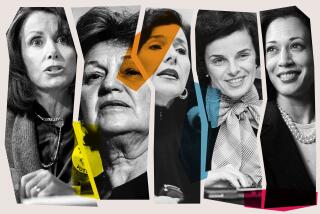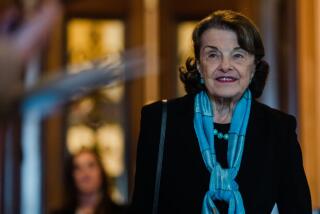To Catch The Wind : Feinstein and Wilson Latch Onto Popular Initiatives In The Hope Of Boosting Their Appeal.
- Share via
Once upon a time, there were two small boats racing for the California mainland. After weeks of pitching about in murky waters, they sat totally becalmed, at the mercy of winds and currents beyond their control.
A storm blew up in the far-off Persian Gulf. And the little attention that people gave to the race shifted.
Then, a continent away, the U.S. government came to a grinding halt, and spectators really began to grow distracted. “Who cares about a race where nothing happens and nobody wins?” they groused. And the two little boats rocked back and forth and got nowhere.
The boats, of course, are the gubernatorial campaigns of Democrat Dianne Feinstein and Republican Pete Wilson, as they chart their course from the first debate to Nov. 6. And this is a fable--a simplistic one at that. But so are the campaigns. They turn on expectations, not reality.
The first debate between the two candidates was a reflection of strategies that have avoided the whirlpools of complex issues, the dismal squalls of tough problems and the risks of tacking against the prevailing winds.
For a while it looked like the Wilson boat would have an advantage, because it had more fuel. Even Feinstein’s own crew described her craft as “running on fumes.” Then came the court ruling that overturned Proposition 73’s limits on campaign contributions. That allowed Feinstein to fuel up with new money and remain competitive.
Both campaigns set out, hoping to cruise safely--and first--into Sacramento harbor.
What happened? Where are they? And does anybody care--have all the spectators lost interest and just gone home?
After navigating the shoals of the first debate, both campaigns are still afloat; the race is very much on. The candidates made it through by hugging familiar coastline. Each charted a course and doggedly stuck to it. There are lessons to be learned from those tactics and signposts to see us through to the election.
What the debate proved was that a candidate can answer--or evade--any question as he or she chooses, no matter how it is asked or who asks it. So much for using this strange hybrid of a dual press conference and high school oratory to shed light on anything that the candidates don’t want to be exposed.
The big news from the debate may well have been the issues that weren’t addressed:
Health care. There was no recognition of the potential implosion of the state’s health-care delivery system.
Insurance reform. A throwaway line.
The homeless. As invisible in this campaign as they are in the eyes of society.
Fiscal problems. Despite the fact there is a budget debacle brewing in Sacramento as threatening to California’s economy as the one rocking Washington is to the nation’s, neither candidate broached a solution.
Whoever is elected governor will have to hit the ground at full gallop with a plan to deal with an estimated revenue shortfall of at least $500 million. If the economy is in a tailspin, if voters approve the initiatives on the ballot that require new funding or earmarked revenues, that estimate could rise to $2 billion or more.
In the face of increasing fiscal inflexibility--imposed on California’s governors by legal mandates and ballot-box budgeting--where does each candidate propose to find the money to balance a seriously out-of-whack budget?
We don’t know what their taxing and spending priorities might be--beyond buzzwords and generalities. Or how each would move to unshackle the state budget process.
And we are not likely to know very much before Election Day. In today’s campaign environment, if the candidates dared to tell us what they would actually do , it could spell political disaster for them.
That is one of the reasons why “change” and “leadership” were the topics of choice in the first debate. These terms define style rather than substance. And they are likely to be the buzzwords for the duration of the campaign.
Because it failed to underscore many real, substantial differences between the contenders, the debate seemed to turn on style and emotion--on which way each candidate felt a favorable wind was blowing. There is every indication that the election, too, will turn on style and emotion--if not political pandering.
If that is the case, turnout--not only how may people vote but what the electorate looks like--may well determine the next governor.
The reality is that both candidates have engaged in “weather-vane” politics. Each is bent on using initiatives on the November ballot to catch a friendly breeze.
Early on--when a powerful environmental wind was blowing--Feinstein aligned herself with “Big Green,” Proposition 128, banking on a heavy turnout of committed environmentalists to boost her chances. But there appears to be no big bang for Big Green. Will that trim her sails? Will her support for the massive goals of Proposition 128 allow her instantly to “out-environmentalist” Republican Wilson? Or will her linkage with what opponents have disdainfully called “the Hayden initiative,” after Assemblyman Tom Hayden (D-West Los Angeles), prove to be a drag?
Wilson felt a gust of wind blowing across the land, knocking down incumbents in its path. “Voter dissatisfaction,” it whistled. And he tacked in the direction of Proposition 140, Los Angeles County Supervisor Pete Schabarum’s Draconian term-limitations initiative on the November ballot.
It is clear that Wilson and crew hoped this dramatic endorsement would lift his campaign out of the doldrums. It did grab a few post-debate headlines, but it’s unclear whether Wilson has been given a push strong enough to blast him into the lead.
Here is a candidate who, until the moment during the debate when he endorsed Proposition 140, based his campaign on a long record of experience in government. How credible is his endorsement of an initiative that prohibits a long record of experience in government?
On the other hand, will Wilson succeed in using term limits to hang the Legislature around Feinstein’s neck--linking her to the banana republic that has been Sacramento these past few years?
Can Wilson’s endorsement of Proposition 140 be written off as a sop to the conservative wing of the Republican Party--which has been less than enthusiastic about his candidacy? Will it bring the right wing out to vote for term limits and Wilson? Will this allow the incumbent U.S. senator instantly to position himself as “Mr. Political Outsider”? Or will Californians opting for “change” vote for 140 and Feinstein--who, by not being a man, simply embodies change?
The bad news for both contenders is that, historically, it has been difficult to tie a candidacy to an initiative--particularly a proposal that wasn’t the candidate’s right from the start. That sail may be full of holes.
From the very beginning, this campaign has been fraught with unchartable whirlwinds. Political tradition suggests “October surprises” yet to come. More federal budget lunacy? A recession? War with Iraq? A spate of new Sacramento indictments? Another round of sniper fire over the candidates’ spouses’ financial disclosures?
Whatever is in store, most likely it will not be a discussion how each candidate would govern-- really govern.
In a few days, the candidates will meet again. If the issue to be debated is change, Wilson ought to tell us how his tenure in the governor’s office will offer change from the policies of his fellow Republican, George Deukmejian, California’s incumbent governor.
If the issue is leadership, Feinstein ought to tell us how she will challenge the Democratic leaders in the Legislature today.
Someone once said of John F. Kennedy, “He did not fear the weather and did not trim his sails, but instead challenged the wind to improve its direction and cause it to blow more softly and kindly over the world and its people.” Now there is a different sense of leadership, of change. Not two small boats listing in the water, waiting for a favorable breeze to blow their way.
More to Read
Get the L.A. Times Politics newsletter
Deeply reported insights into legislation, politics and policy from Sacramento, Washington and beyond. In your inbox three times per week.
You may occasionally receive promotional content from the Los Angeles Times.










